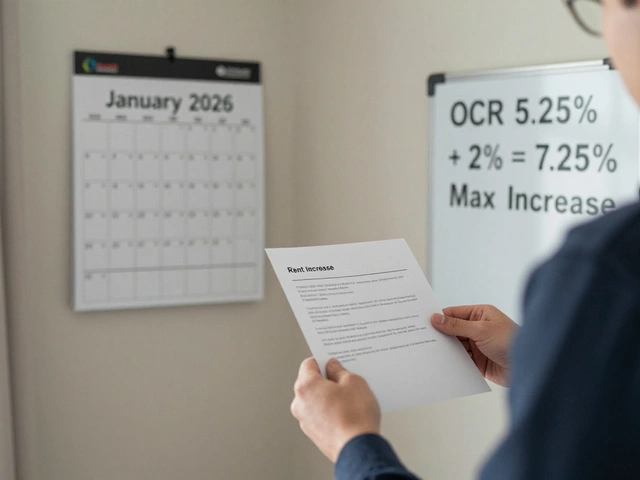What Is a Good Cash‑on‑Cash Return for Commercial Property?

Key Takeaways
- A solid cash-on-cash return for commercial real estate usually sits between 8% and 12%.
- The metric ignores appreciation and tax effects, focusing only on actual cash in and out.
- Debt service, vacancy, and operating expenses are the biggest levers you can pull to improve the number.
- Compare cash‑on‑cash return with cap rate and IRR to get a fuller picture of risk and upside.
- Use a short checklist after each deal review to spot red flags before you sign.
When you hear investors talk about a "good cash‑on‑cash return," they’re usually referencing a quick‑look profitability gauge for a commercial property. The figure tells you how much cash you earn each year compared to the cash you actually put into the deal. It’s handy because it cuts through complex tax rules, projected appreciation, and even financing quirks, giving you a plain‑English percentage you can stack against other opportunities.
Cash-on-Cash Return is the annual cash income generated by an investment divided by the total cash invested. In practice you calculate it by taking the net cash flow after all expenses and debt service, then dividing that by the cash you actually spent at closing (down payment, closing costs, and any upfront repairs). The result is expressed as a percentage.
While the formula is simple, interpreting the result requires context. A 5% return might look low, but if the property is in a high‑risk market or has a very thin margin, 5% could be reasonable. Conversely, a 15% cash‑on‑cash return on a well‑located office building might signal that the seller is leaving money on the table-or that you’re underestimating hidden costs.
Commercial Property refers to any real‑estate asset used for business purposes, such as office, retail, industrial, or multifamily buildings. These assets differ from residential homes in how they generate income (usually through lease contracts) and how they’re financed (often with higher leverage ratios).
How to Calculate Cash‑on‑Cash Return
- Determine total cash invested:
- Down payment (usually 20‑30% of purchase price)
- Closing costs (legal fees, title search, stamp duty)
- Up‑front capital expenditures (renovations, tenant improvements)
- Calculate annual net cash flow:
- Take projected gross rental income.
- Subtract Operating Expenses (property management, insurance, utilities, taxes, and routine maintenance).
- Subtract the yearly Debt Service (principal and interest payments on the mortgage).
- Divide net cash flow by total cash invested and multiply by 100 to get a percentage.
Example: You buy a downtown office building for $2 million. You put down 25% ($500 k), pay $30 k in closing costs, and spend $70 k on tenant improvements. Total cash outlay = $600 k. The property generates $120 k gross rent per year. Operating expenses total $30 k, and debt service is $45 k. Net cash flow = $120 k - $30 k - $45 k = $45 k. Cash‑on‑cash return = ($45 k / $600 k) × 100 = 7.5%.
What Numbers Count as “Good”?
| Property Type | Typical Low End | Average Range | High‑End / “Good” |
|---|---|---|---|
| Office | 5‑6% | 7‑9% | 10‑12%+ |
| Retail | 6‑7% | 8‑10% | 11‑13%+ |
| Industrial | 7‑8% | 9‑11% | 12‑14%+ |
| Multifamily (5+ units) | 4‑5% | 6‑8% | 9‑11%+ |
These ranges aren’t set in stone. They reflect typical market expectations in stable economies like the United States, Canada, Australia, and New Zealand as of 2025. In high‑growth markets (e.g., certain Asian metros) the “good” band can stretch higher, while in slower or over‑built markets it can compress.

Key Factors That Push the Percentage Up or Down
- Debt Structure: A lower loan‑to‑value (LTV) ratio reduces debt service, boosting cash flow. However, using too little leverage can waste cheap financing.
- Vacancy Rate: Vacancy Rate (percentage of rentable space that sits empty) directly cuts rental income. Keep it below market averages.
- Operating Efficiency: Cutting unnecessary expenses-like over‑paying for property management-improves the net cash flow.
- Consider Capital Expenditures (large, infrequent outlays for major repairs or upgrades) as a separate line item; they’re not part of regular operating costs but affect cash availability.
- Market Rent: Higher-than‑average rent can create upside, but verify lease comps to avoid over‑optimism.
- Tax Considerations: While cash‑on‑cash ignores tax, real‑world cash flow does get affected by depreciation shields and interest deductions. Ignoring them can mislead you about true after‑tax returns.
How Cash‑on‑Cash Compares to Other Return Metrics
The most common alternative is the Cap Rate (Net operating income divided by purchase price). Cap rate ignores financing, so it’s useful when you want to compare properties regardless of how you’ll fund them. Cash‑on‑cash, by contrast, tells you how your own money performs after debt.
Another metric is the Internal Rate of Return (IRR) (the discount rate that makes the net present value of cash flows zero). IRR captures the time value of money and future resale proceeds-great for long‑term investors but harder to calculate and explain to partners.
In practice, savvy investors look at all three. If a property shows a 9% cash‑on‑cash return, an 8% cap rate, and a 15% IRR, you have a well‑rounded picture: decent cash yield, solid market valuation, and attractive long‑term upside.

Quick Deal‑Review Checklist
- Confirm total cash outlay (down payment, closing, cap‑ex).
- Project first‑year gross rent based on signed leases and market comps.
- Itemize operating expenses, including property management, insurance, taxes, and a reserve for repairs.
- Calculate annual debt service using the exact loan terms you expect.
- Run the cash‑on‑cash formula and compare it against the benchmark table above.
- Cross‑check with cap rate and IRR to ensure no hidden downside.
- Stress‑test the numbers by raising vacancy by 2‑3% and adding a 5% cap‑ex reserve.
If the cash‑on‑cash return stays above 8% after the stress test, you’re generally in a comfortable zone for most commercial markets in 2025.
Common Pitfalls to Avoid
- Counting projected appreciation as part of cash flow-cash‑on‑cash is a snapshot, not a forecast.
- Including non‑recurring tax benefits (like depreciation) in the numerator.
- Under‑estimating vacancy or tenant turnover costs; always use a conservative vacancy assumption.
- Ignoring future capital expenditures; a roof replacement can drain cash in year 3.
- Using a loan rate that’s not realistic for your credit profile; banks won’t give you a 3% rate if your credit score is below 700.
Frequently Asked Questions
What is the difference between cash‑on‑cash return and cap rate?
Cash‑on‑cash return looks at the cash you actually invest versus the cash you get back each year, factoring in debt service. Cap rate measures the property’s net operating income against the purchase price and ignores financing.
Is a higher cash‑on‑cash return always better?
Not necessarily. A very high cash‑on‑cash return can signal higher risk-like a property in a volatile market, a tenant base with short leases, or deferred maintenance that will hit cash flow later.
How often should I recalculate cash‑on‑cash return?
At a minimum, once a year after you have actual rent rolls and expenses. Many owners do it quarterly to catch any drift early.
Can cash‑on‑cash return be negative?
Yes. If operating expenses and debt service exceed the rental income, the net cash flow is negative, resulting in a negative cash‑on‑cash return. That’s a red flag.
Does cash‑on‑cash return include tax benefits?
No. The metric is purely cash‑in vs. cash‑out. Tax deductions like depreciation must be considered separately, often via after‑tax cash‑on‑cash calculations.


